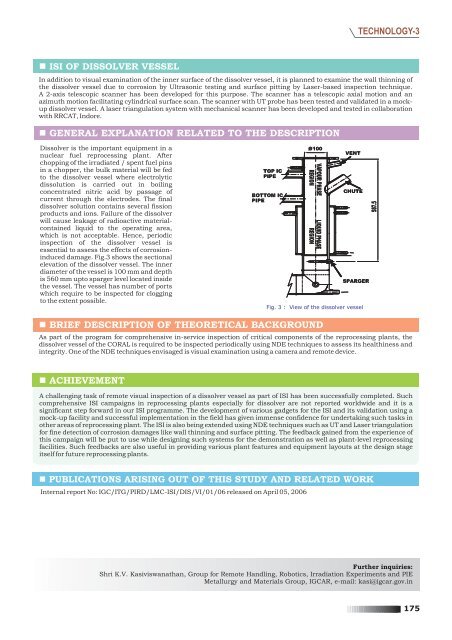Remote Visual Inspection of a Dissolver Vessel in Fast Reactor Fuel ...
Remote Visual Inspection of a Dissolver Vessel in Fast Reactor Fuel ...
Remote Visual Inspection of a Dissolver Vessel in Fast Reactor Fuel ...
You also want an ePaper? Increase the reach of your titles
YUMPU automatically turns print PDFs into web optimized ePapers that Google loves.
TECHNOLOGY-3<br />
ISI OF DISSOLVER VESSEL<br />
In addition to visual exam<strong>in</strong>ation <strong>of</strong> the <strong>in</strong>ner surface <strong>of</strong> the dissolver vessel, it is planned to exam<strong>in</strong>e the wall th<strong>in</strong>n<strong>in</strong>g <strong>of</strong><br />
the dissolver vessel due to corrosion by Ultrasonic test<strong>in</strong>g and surface pitt<strong>in</strong>g by Laser-based <strong>in</strong>spection technique.<br />
A 2-axis telescopic scanner has been developed for this purpose. The scanner has a telescopic axial motion and an<br />
azimuth motion facilitat<strong>in</strong>g cyl<strong>in</strong>drical surface scan. The scanner with UT probe has been tested and validated <strong>in</strong> a mockup<br />
dissolver vessel. A laser triangulation system with mechanical scanner has been developed and tested <strong>in</strong> collaboration<br />
with RRCAT, Indore.<br />
GENERAL EXPLANATION RELATED TO THE DESCRIPTION<br />
<strong>Dissolver</strong> is the important equipment <strong>in</strong> a<br />
nuclear fuel reprocess<strong>in</strong>g plant. After<br />
chopp<strong>in</strong>g <strong>of</strong> the irradiated / spent fuel p<strong>in</strong>s<br />
<strong>in</strong> a chopper, the bulk material will be fed<br />
to the dissolver vessel where electrolytic<br />
dissolution is carried out <strong>in</strong> boil<strong>in</strong>g<br />
concentrated nitric acid by passage <strong>of</strong><br />
current through the electrodes. The f<strong>in</strong>al<br />
dissolver solution conta<strong>in</strong>s several fission<br />
products and ions. Failure <strong>of</strong> the dissolver<br />
will cause leakage <strong>of</strong> radioactive materialconta<strong>in</strong>ed<br />
liquid to the operat<strong>in</strong>g area,<br />
which is not acceptable. Hence, periodic<br />
<strong>in</strong>spection <strong>of</strong> the dissolver vessel is<br />
essential to assess the effects <strong>of</strong> corrosion<strong>in</strong>duced<br />
damage. Fig.3 shows the sectional<br />
elevation <strong>of</strong> the dissolver vessel. The <strong>in</strong>ner<br />
diameter <strong>of</strong> the vessel is 100 mm and depth<br />
is 560 mm upto sparger level located <strong>in</strong>side<br />
the vessel. The vessel has number <strong>of</strong> ports<br />
which require to be <strong>in</strong>spected for clogg<strong>in</strong>g<br />
to the extent possible.<br />
Fig. 3 : View <strong>of</strong> the dissolver vessel<br />
BRIEF DESCRIPTION OF THEORETICAL BACKGROUND<br />
As part <strong>of</strong> the program for comprehensive <strong>in</strong>-service <strong>in</strong>spection <strong>of</strong> critical components <strong>of</strong> the reprocess<strong>in</strong>g plants, the<br />
dissolver vessel <strong>of</strong> the CORAL is required to be <strong>in</strong>spected periodically us<strong>in</strong>g NDE techniques to assess its health<strong>in</strong>ess and<br />
<strong>in</strong>tegrity. One <strong>of</strong> the NDE techniques envisaged is visual exam<strong>in</strong>ation us<strong>in</strong>g a camera and remote device.<br />
ACHIEVEMENT<br />
A challeng<strong>in</strong>g task <strong>of</strong> remote visual <strong>in</strong>spection <strong>of</strong> a dissolver vessel as part <strong>of</strong> ISI has been successfully completed. Such<br />
comprehensive ISI campaigns <strong>in</strong> reprocess<strong>in</strong>g plants especially for dissolver are not reported worldwide and it is a<br />
significant step forward <strong>in</strong> our ISI programme. The development <strong>of</strong> various gadgets for the ISI and its validation us<strong>in</strong>g a<br />
mock-up facility and successful implementation <strong>in</strong> the field has given immense confidence for undertak<strong>in</strong>g such tasks <strong>in</strong><br />
other areas <strong>of</strong> reprocess<strong>in</strong>g plant. The ISI is also be<strong>in</strong>g extended us<strong>in</strong>g NDE techniques such as UT and Laser triangulation<br />
for f<strong>in</strong>e detection <strong>of</strong> corrosion damages like wall th<strong>in</strong>n<strong>in</strong>g and surface pitt<strong>in</strong>g. The feedback ga<strong>in</strong>ed from the experience <strong>of</strong><br />
this campaign will be put to use while design<strong>in</strong>g such systems for the demonstration as well as plant-level reprocess<strong>in</strong>g<br />
facilities. Such feedbacks are also useful <strong>in</strong> provid<strong>in</strong>g various plant features and equipment layouts at the design stage<br />
itself for future reprocess<strong>in</strong>g plants.<br />
PUBLICATIONS ARISING OUT OF THIS STUDY AND RELATED WORK<br />
Internal report No: IGC/ITG/PIRD/LMC-ISI/DIS/VI/01/06 released on April 05, 2006<br />
Further <strong>in</strong>quiries:<br />
Shri K.V. Kasiviswanathan, Group for <strong>Remote</strong> Handl<strong>in</strong>g, Robotics, Irradiation Experiments and PIE<br />
Metallurgy and Materials Group, IGCAR, e-mail: kasi@igcar.gov.<strong>in</strong><br />
175
















